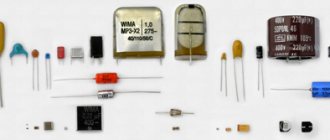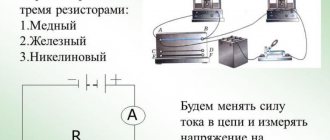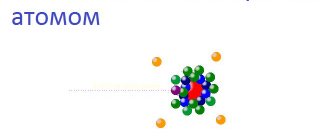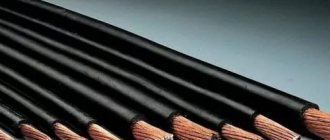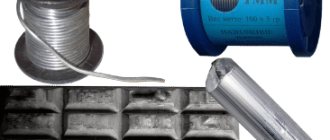The relatively low resistivity of copper is an important, but not the only positive factor. The widespread use of this material is explained by its reasonable cost and resistance to adverse external influences. It is easy to create high-quality products of the required shape from it, which, without additional protection, retain functionality during long-term use in difficult conditions.
Various types of cable products are made from copper
General characteristics of copper
Speaking about copper, it must be said that at the dawn of the electrical era it began to be used in the production of electrical equipment. It began to be used largely due to the unique properties that this alloy has. By itself, it is a material characterized by high properties in terms of ductility and good malleability.
Along with the thermal conductivity of copper, one of its most important advantages is its high electrical conductivity. It is thanks to this property that copper has become widespread in power plants , in which it acts as a universal conductor. The most valuable material is electrolytic copper, which has a high degree of purity of 99.95%. Thanks to this material, it becomes possible to produce cables.
This is interesting: Performance characteristics and advantages of copper pipes and fittings for plumbing
Chemical properties
According to these characteristics, copper, whose electrical and thermal conductivity is very high, occupies an intermediate position between the elements of the first triad of the eighth group and the alkali elements of the first group of the periodic table. Its main chemical properties include:
- tendency to form complexes;
- ability to produce colored compounds and insoluble sulfides.
The most characteristic of copper is the divalent state. It has practically no similarity with alkali metals. Its chemical activity is also low. In the presence of CO2 or moisture, a green carbonate film forms on the copper surface. All copper salts are toxic substances. In mono- and divalent states, this metal forms very stable complex compounds. Ammonia compounds are of greatest importance for industry.
Parameters and features
This name is an alloy of copper-nickel composition, characterized by thermal stability, electrical resistance, workability, and is used in the electrical industry.
The main features are considered to be the electrical properties of constantan MNMts 40-1.5: high electrical resistivity, amounting to 0.45-0.52 μOhm×m, and low temperature coefficient of electrical resistance, equal to -0.02 × 10-3-+0, 06×10-3 °C-1.
The latter ensures resistance stability at different temperatures. Due to its resistance parameters, constantan is called a resistive alloy. In addition, this material is characterized by a significant thermoelectromotive force. Finally, constantan has good technological properties, which make it machinable by mechanical methods. So, soldering, embossing, stamping, forging, etc. are applicable to it. After annealing, cutting can be used. Zinc contamination makes processing significantly more difficult.
The following are other characteristics of constantan. Its density is 8.8–8.9 g/cm3. Thus, it is the densest nickel alloy, surpassing steel in this parameter. This feature, which determines the large mass of constantan, is due to the significant proportion of copper in its composition. The melting point is 1260 °C, due to which the alloy is thermally stable, maintaining its internal structure up to the specified temperature. Hardness is 155 HB, tensile strength is 400 MPa. The thermal coefficient of linear expansion is 14.4×10-6 in the range from 20 to 100 °C. The heat capacity is 0.0977 cal/g×C, thermal conductivity is 0.05 cal/cm×s×C. There are no magnetic properties. Constantan is characterized by high ductility. Thus, the elastic modulus is 16600 kgf/mm2, the relative elongation reaches 30%, and the contraction is 71%. It should be noted that ductility is significantly reduced when constantan is contaminated with zinc. Due to its high endurance limit of 243 MPa for hot-woven rods (equivalent to steel 45), constantan is suitable for variable load conditions. The copper-nickel composition ensures the alloy's resistance to corrosion. Thus, it does not react with oxygen up to 800 °C, as well as with organic acids and salt solutions. Color – yellowish.
Due to its low strength, constantan is often subjected to additional processing. After annealing, the tensile strength increases to 700-800 MPa, which equates the alloy in this indicator to steel 45. To further strengthen the material in question, cold hardening is used, which involves surface rolling with steel rollers, causing plastic deformation. As a result of this treatment, constantan acquires a tensile strength of 850 MPa and a hardness of 75-90 HB. However, it must be taken into account that both mechanical and thermal treatment of constantan MNMts 40-1.5 reduces ductility: relative elongation is reduced to 4%, contraction - to 21%.
It should be noted that electrical insulating parameters are characteristic not of the material, but of the surface oxide film.
This coating is formed as a result of calcination, therefore products designed for use in electrical equipment are subjected to this treatment during production.
The cost of constantan is formed primarily under the influence of the price of Ni. For example, the cost of the material in question in October 2017 averaged 5 thousand rubles per 1 kg. It largely depends on the shape and its features. So, tape is a little more expensive compared to wire. And for wire, thickness matters: options with a larger diameter are cheaper. For example, as of December 2022, a ton of 0.6 mm wire cost about 2.3 million, and material with a diameter of 1.2 mm - 0.8-1 million. Moreover, as can be seen from the data given, with mass sales the price is significantly reduced. The purchase price is also determined by several factors. Firstly, the condition of the scrap is of great importance, determined primarily by the presence of traces of corrosion. Secondly, the diameter matters for the wire. Thin materials are more valuable.
Thirdly, the volume of supplies is important. Scrap collection points prefer to accept large quantities (more than 100 kg) due to accelerated sales. In such cases, they mark up scrap by 10–15%.
How to identify metal?
Visually distinguish brass alloys from copper. To do this, the object is cleaned of oxides using table vinegar, which is added to the aqueous solution. Compare two products, their main differences and determine the metal.
By color
Copper has a red tint, while brass has a golden tint. Brass can appear in a variety of colors. It depends on the amount of zinc. If the alloy contains 5–20%, the tint will be reddish.
The composition contains 20–36% of the element, brass has a yellow tint. Typically, the alloy contains a large amount of Zn.
When a brass object is struck, the sound is loud, while a copper object is muffled.
By labeling
Metal is easy to distinguish if you know its markings. Brass can be two-component or multi-component. Alloying elements affect the properties of brass.
If the alloy contains tin, the strength and resistance to corrosion increases. Manganese increases the strength of the product. Lead impairs mechanical properties. At the same time, the material is easy to process. Silicon negatively affects the strength of the alloy with brass.
If lead is added in addition to Si, the alloy becomes durable. This is due to the low coefficient of friction. This property of alloys is used for the manufacture of shafts and bearings.
Two-component brass is marked with the letter “L”, which indicates the type of alloy. Then they write two numbers that indicate the amount of copper. For example, L80 means that the alloy contains 80% copper, 20% zinc.
Marking of multi-component brass. “L” comes first, followed by letters and numbers. They indicate the amount of additive in the alloy. First there is metal, of which there is more.
There are the following grades of copper: M00; M0; M06; M1; M1p; M2; M2p; M3; M3p; M4.
Copper and bronze, what are the differences? Bronze can be tin or tinless. The second contains:
An analogue of bronze is obtained with the addition of zinc and nickel. This alloy is called spiater.
Bronze markings begin with the letters “Br”. Next, indicate the alloying elements that are part of the alloy.
By density
Metal can be identified by its density. First you need to weigh the product. After this, determine the volume of the specimen by measuring an object of the correct shape.
If the product has an irregular shape, the volume is determined by measuring by displacement. The body is immersed in a vessel, first fixing the water level. The change rate is then recorded. Then the difference between the levels is calculated. The result is multiplied by the area of water and the volume of the object is obtained.
The density of the metal is calculated by dividing the mass of the object by the volume (ρ = m/V).
By heating
Elements are recognized when copper and alloys are heated. Cu reacts with hydrogen and acids. Brass is covered with an ash-colored film, but bronze does not change.
How to identify copper and brass at home
Important: if the alloy of copper and zinc has a low percentage of the former (less than 20%), then the resulting material will have a very pronounced shade of yellow. As the zinc content increases, the saturation of the tide becomes lower.
Expert opinion
It-Technology, Electrical power and electronics specialist
Ask questions to the “Specialist for modernization of energy generation systems”
ORIGIN The specified brass alloy has high quality characteristics in terms of ductility, resistance to friction and resistance to rust. Ask, I'm in touch!
The essence of the phenomenon
This is a value characteristic of a conductor having a length of 1 meter and a cross-sectional area of 1 square meter/millimeter. It is denoted by the Greek letter ρ. Different materials have different resistivities. At the same time, the resistance of the conductor will change in direct proportion to the length and in inverse proportion to the cross-sectional area. That is, the longer the conductor, the higher it is, but the greater the thickness, the lower it is.
Length
General information about electrical resistance
First, we should consider the concept of electrical resistance. As is known, under the influence of electric current on a conductor (and copper is one of the best conductor metals), some of the electrons in it leave their place in the crystal lattice and rush towards the positive pole of the conductor. However, not all electrons leave the crystal lattice; some of them remain in it and continue to rotate around the atomic nucleus. It is these electrons, as well as atoms located at the nodes of the crystal lattice, that create electrical resistance that prevents the movement of released particles.
This process, which we briefly outlined, is typical for any metal, including copper. Naturally, different metals, each of which has a special shape and size of the crystal lattice, resist the passage of electric current through them in different ways. It is precisely these differences that characterize resistivity - an indicator individual for each metal.
Electrical resistivity of some substances
Electrical conductivity
So far, we have considered the resistance of a conductor as the obstacle that the conductor provides to the electric current. But still, current flows through the conductor. Therefore, in addition to resistance (obstacle), the conductor also has the ability to conduct electric current, that is, conductivity.
The more resistance a conductor has, the less conductivity it has, the worse it conducts electric current, and, conversely, the lower the resistance of a conductor, the more conductivity it has, the easier it is for current to pass through the conductor. Therefore, the resistance and conductivity of a conductor are reciprocal quantities.
From mathematics we know that the reciprocal of 5 is 1/5 and, conversely, the reciprocal of 1/7 is 7. Therefore, if the resistance of a conductor is denoted by the letter r, then the conductivity is defined as 1/r. Conductivity is usually symbolized by the letter g.
Electrical conductivity is measured in (1/Ohm) or in siemens.
Example 8. The conductor resistance is 20 ohms. Determine its conductivity.
If r = 20 Ohm, then
Example 9. The conductivity of the conductor is 0.1 (1/Ohm). Determine its resistance
If g = 0.1 (1/Ohm), then r = 1 / 0.1 = 10 (Ohm)
Temperature coefficient of resistance
All metals with any thermal conductivity have the property of decreasing conductivity with increasing temperature. As the temperature decreases, conductivity increases. Experts call the property of decreasing resistance with decreasing temperature particularly interesting. Indeed, in this case, when the temperature in the room drops to a certain value, the electrical resistance of the conductor may disappear and it will become a superconductor.
In order to determine the resistance value of a particular conductor of a certain weight at room temperature, there is a critical resistance coefficient. It is a value that shows the change in resistance of a section of a circuit when the temperature changes by one Kelvin. To calculate the electrical resistance of a copper conductor in a certain time period, use the following formula:
ΔR = α*R*ΔT, where α is the temperature coefficient of electrical resistance.
What does thermal conductivity depend on?
Studying the ability of heat transfer by metal products, it was revealed that thermal conductivity depends on:
- type of metal;
- chemical composition;
- porosity;
- sizes.
Metals have different crystal lattice structures, and this can change the thermal conductivity of the material. For example, in steel and aluminum, the structural features of microparticles affect differently the rate of transfer of thermal energy through them.
The thermal conductivity coefficient can have different values for the same metal when the exposure temperature changes. This is due to the fact that different metals have different melting degrees, which means that under other environmental parameters, the properties of the materials will also differ, and this will affect thermal conductivity.
Alloy characteristics
The electrical conductivity of metals can depend not only on the amount of impurities present in them, but also on other indicators. For example, as the heating temperature increases, the ability of copper to pass current through itself decreases. Even the method of its manufacture affects the electrical conductivity of such wire. In everyday life and in production, both soft annealed copper conductors and hard-drawn ones can be used. The first variety has a higher ability to pass current through itself.
However, the additives used and their quantity have the greatest influence on the electrical conductivity of copper. The table below provides the reader with comprehensive information regarding the current carrying capacity of the most common alloys of this metal. Electrical conductivity of copper alloys
| Alloy | Condition (O - annealed, T - hard-drawn) | Electrical conductivity (%) |
| Pure copper | ABOUT | 101 |
| T | 98 | |
| Tin bronze (0.75%) | ABOUT | 55-60 |
| T | 50-55 | |
| Cadmium bronze (0.9%) | ABOUT | 95 |
| T | 83-90 | |
| Aluminum bronze (2.5% A1, 2% Sn) | ABOUT | 15-18 |
| T | 15-18 | |
| Phosphor bronze (7% Sn, 0.1% P) | ABOUT | 10-15 |
| T | 10-15 |
The electrical conductivity of brass and copper is comparable. However, for the first metal this figure is, of course, slightly lower. But at the same time it is higher than that of bronzes. Brass is used quite widely as a conductor. It passes current worse than copper, but at the same time it costs less. Most often, contacts, clamps and various parts for radio equipment are made from brass.
Connection of copper and aluminum wires
Recently, electrical equipment of increasingly higher power has begun to be used in everyday life and industry. During Soviet times, wiring was made mainly of cheap aluminum. Unfortunately, its performance characteristics no longer meet the new requirements. Therefore, today in everyday life and in industry very often aluminum wires are replaced with copper ones. The main advantage of the latter, in addition to refractoriness, is that during the oxidation process their conductive properties do not decrease.
Often when modernizing electrical networks, aluminum and copper wires have to be connected. This cannot be done directly. Actually, the electrical conductivity of aluminum and copper does not differ too much. But only for these metals themselves. The oxidizing films of aluminum and copper have different properties. Because of this, the conductivity at the junction is significantly reduced. The oxidation film of aluminum has much greater resistance than that of copper. Therefore, the connection of these two types of conductors must be made exclusively through special adapters. These could be, for example, clamps containing a paste that protects metals from the appearance of oxide. This adapter option is usually used when connecting wires outdoors. Branch compressors are more often used indoors. Their design includes a special plate that eliminates direct contact between aluminum and copper. If such conductors are not available at home, instead of twisting the wires directly, it is recommended to use a washer and nut as an intermediate “bridge”.
Iron as a conductor in electrical engineering
Iron is the most common metal in nature and technology (after hydrogen, which is also a metal). It is the cheapest and has excellent strength characteristics, therefore it is used everywhere as the basis for the strength of various structures.
In electrical engineering, iron is used as a conductor in the form of flexible steel wires where physical strength and flexibility are needed, and the required resistance can be achieved through the appropriate cross-section.
Having a table of resistivities of various metals and alloys, you can calculate the cross-sections of wires made from different conductors.
As an example, let's try to find the electrically equivalent cross-section of conductors made of different materials: copper, tungsten, nickel and iron wire. Let's take aluminum wire with a cross-section of 2.5 mm as the initial one.
We need that over a length of 1 m the resistance of the wire made of all these metals is equal to the resistance of the original one. The resistance of aluminum per 1 m length and 2.5 mm section will be equal to
Where R
– resistance,
ρ
– resistivity of the metal from the table,
S
– cross-sectional area,
L
– length.
Substituting the original values, we get the resistance of a meter-long piece of aluminum wire in ohms.
After this, let us solve the formula for S
We will substitute the values from the table and obtain the cross-sectional areas for different metals.
Since the resistivity in the table is measured on a wire 1 m long, in microohms per 1 mm 2 section, then we got it in microohms. To get it in ohms, you need to multiply the value by 10 -6. But we don’t necessarily need to get the number ohm with 6 zeros after the decimal point, since we still find the final result in mm2.
As you can see, the resistance of the iron is quite high, the wire is thick.
But there are materials for which it is even greater, for example, nickel or constantan.
Many people have heard about Ohm's law, but not everyone knows what it is. The study begins with a school physics course. They are taught in more detail at the Faculty of Physics and Electrodynamics. This knowledge is unlikely to be useful to the average person, but it is necessary for general development, and for others, for a future profession. On the other hand, basic knowledge about electricity, its structure, and its features at home will help protect yourself from harm. It is not for nothing that Ohm’s law is called the fundamental law of electricity. A home handyman needs to have knowledge in the field of electricity to prevent overvoltage, which can lead to an increase in load and a fire.
What is copper and brass?
Both alloys are very similar, so many people pay attention to the peculiarities of their evaluation. Brass is similar in color to copper, as it is also found in the brass composition. The first alloy can be characterized as follows:
- Brass is a multicomponent copper-based alloy, with zinc used as the main alloying element. In some cases, tin, iron, lead and some other components are added to the composition to change various performance properties. It can be determined by these indicators.
- A similar composition is used in the manufacture of a wide variety of products, in most cases conductive elements. By changing the chemical composition, the alloy can be given special performance characteristics.
Expert opinion
It-Technology, Electrical power and electronics specialist
Ask questions to the “Specialist for modernization of energy generation systems”
How to distinguish copper from brass: 9 methods and characteristics But there are more complex methods that are also effective, but require either special knowledge or the presence of some equipment. Ask, I'm in touch!
Applications of copper in electrical and electronic systems
In order to understand the reason for the popularity of copper as a material for the manufacture of elements of electrical and electronic systems, it is enough to look at the value of its resistivity in the table. For copper, this parameter is 0.0175 Ohm*mm2/meter. In this regard, copper is second only to silver.
It is the low resistivity, measured at a temperature of 20 degrees Celsius, that is the main reason that almost no electronic and electrical device can do without copper today. Copper is the main material for the production of wires and cables, printed circuit boards, electric motors and power transformer parts.
The low resistivity that copper is characterized by allows it to be used for the manufacture of electrical devices characterized by high energy-saving properties. In addition, the temperature of copper conductors increases very little when electric current passes through them.
Dependence of copper resistance on temperature
Physical properties
Thus, we found out what electrical conductivity copper has.
This indicator may vary depending on the impurities contained in the metal. However, the demand for copper in industry is also determined by its other useful physical properties, information about which can be obtained from the table below. Physical characteristics of Cu
| Parameter | Meaning |
| Lattice | Face-centered cubic, a=3.6074 Å |
| Atomic radius | 1.28 Å |
| Specific heat | 385.48 J/(kg K) at +20 °C |
| Thermal conductivity | 394.279 W/(m K) at +20 °C |
| Electrical resistance | 1.68 10-8 Ohm m |
| Linear expansion coefficient | 17,0·10-6 |
| Hardness | 350 Mn/m2 |
| Tensile strength | 220 Mn/m2 |
Copper is the main material for conductors
The resistivity of a substance is calculated using the formula, where one of the important indicators is the temperature coefficient of electrical resistance. The table contains the resistivity values of three known metals in the temperature range from 0 to 100°C.
If we take the resistivity of iron, as one of the available materials, equal to 0.1 Ohm, then for 1 Ohm you will need 10 meters. Silver has the lowest electrical resistance; for its value of 1 ohm it will be 66.7 meters. A significant difference, but silver is an expensive metal that is not practical to use everywhere. The next best indicator is copper, where 57.14 meters are required per 1 ohm. Due to its availability and cost compared to silver, copper is one of the popular materials for use in electrical networks. The low resistivity of copper wire or the resistance of copper wire makes it possible to use copper conductor in many branches of science, technology, as well as for industrial and domestic purposes.
Conductor resistivity table
| Conductor material | Specific resistance ρ in |
| Silver Copper Gold Brass Aluminum Sodium Iridium Tungsten Zinc Molybdenum Nickel Bronze Iron Steel Tin Lead Nickelin (an alloy of copper, nickel and zinc) Manganin (an alloy of copper, nickel and manganese) Constantan (an alloy of copper, nickel and aluminum) Titanium Mercury Nichrome (an alloy of nickel, chromium, iron and manganese) Fechral Bismuth Chromal | 0,015 0,0175 0,023 0,025… 0,108 0,028 0,047 0,0474 0,05 0,054 0,059 0,087 0,095… 0,1 0,1 0,103… 0,137 0,12 0,22 0,42 0,43… 0,51 0,5 0,6 0,94 1,05… 1,4 1,15… 1,35 1,2 1,3… 1,5 |
The table shows that an iron wire with a length of 1 m and a cross-section of 1 mm2 has a resistance of 0.13 Ohm. To get 1 Ohm of resistance you need to take 7.7 m of such wire. Silver has the lowest resistivity. 1 Ohm of resistance can be obtained by taking 62.5 m of silver wire with a cross section of 1 mm2. Silver is the best conductor, but the cost of silver excludes the possibility of its mass use. After silver in the table comes copper: 1 m of copper wire with a cross-section of 1 mm2 has a resistance of 0.0175 Ohm. To get a resistance of 1 ohm, you need to take 57 m of such wire.
Chemically pure copper, obtained by refining, has found widespread use in electrical engineering for the manufacture of wires, cables, windings of electrical machines and devices. Aluminum and iron are also widely used as conductors.
The conductor resistance can be determined by the formula:
where r is the conductor resistance in ohms; ρ is the resistivity of the conductor; l is the length of the conductor in m; S - conductor cross-section in mm2.
Example 1. Determine the resistance of 200 m of iron wire with a cross section of 5 mm2.
Example 2. Calculate the resistance of 2 km of aluminum wire with a cross section of 2.5 mm2.
From the resistance formula you can easily determine the length, resistivity and cross-section of the conductor.
Example 3. For a radio receiver, it is necessary to wind a 30 Ohm resistance from nickel wire with a cross section of 0.21 mm2. Determine the required wire length.
Example 4. Determine the cross-section of 20 m of nichrome wire if its resistance is 25 Ohms.
Example 5. A wire with a cross section of 0.5 mm2 and a length of 40 m has a resistance of 16 Ohms. Determine the wire material.
The material of the conductor characterizes its resistivity.
Based on the resistivity table, we find that lead has this resistance.
It was stated above that the resistance of conductors depends on temperature. Let's do the following experiment. Let's wind several meters of thin metal wire in the form of a spiral and connect this spiral to the battery circuit. To measure current, we connect an ammeter to the circuit. When the coil is heated in the burner flame, you will notice that the ammeter readings will decrease. This shows that the resistance of a metal wire increases with heating.
For some metals, when heated by 100°, the resistance increases by 40 - 50%. There are alloys that change their resistance slightly with heating. Some special alloys show virtually no change in resistance when temperature changes. The resistance of metal conductors increases with increasing temperature, while the resistance of electrolytes (liquid conductors), coal and some solids, on the contrary, decreases.
The ability of metals to change their resistance with changes in temperature is used to construct resistance thermometers. This thermometer is a platinum wire wound on a mica frame. By placing a thermometer, for example, in a furnace and measuring the resistance of the platinum wire before and after heating, the temperature in the furnace can be determined.
temperature coefficient of resistance
- this is the change in the resistance of the conductor when it is heated, per 1 ohm of initial resistance and per 1° temperature, denoted by the letter α.
If at temperature t0 the resistance of the conductor is equal to r0, and at temperature t is equal to rt, then the temperature coefficient of resistance
Note. Calculation using this formula can only be done in a certain temperature range (up to approximately 200°C).
We present the values of the temperature coefficient of resistance α for some metals (Table 2).
SCS design - basic requirements
The correct answer to such a question would be to quote from beginning to end all the texts of telecommunication standards :), since all of them are either directly or indirectly related to the design of SCS. Based on these standards, training manuals for SCS manufacturers on the design and installation of their proprietary systems have been written. There are a lot of different requirements and rules; such training courses take several full days. For narrowly formulated questions, we can give a quote from the standard as an answer, but your question is too broad. The only way we can help you is to list the main thematic sections of the most popular standards so that you can navigate which standard you need to find and read.
TIA/EIA-568-B.1 Commercial Building Telecommunications Cabling Standard, Part 1: General Requirements Standard for commercial building telecommunications cabling systems. Part 1: General requirements
- Horizontal subsystem
- Trunk subsystem
- Workplace
- Telecommunications
- Hardware
- City inputs
- Installation requirements
- Transmission performance and testing requirements
TIA/EIA-568-B.2 Commercial Building Telecommunications Cabling Standard, Part 2: Balanced Twisted-Pair Cabling Components Standard for commercial building telecommunications cabling systems. Part 2: Balanced Twisted Pair Cabling Components
- Cables balanced twisted pair 100 Ohm
- 100 Ohm Balanced Twisted Pair Switching Equipment
- Patch cords and cross-connect jumpers
The appendices to this standard provide important information about the parameters and methodology for testing the characteristics of copper cable systems, requirements for measuring equipment, etc.
TIA/EIA-568-B.3 Optical Fiber Cabling Components Standard
- Fiber Optic Cables
- Switching equipment
- Patch cords
- Field testers
TIA/EIA-569 Commercial Building Standard for Telecommunications Pathways and Spaces
- Horizontal routes and associated spaces
- Main routes inside the building and associated spaces
- Workplace
- Telecommunications cabinet
- Hardware
- City input
One of the annexes also provides requirements for main routes between buildings and associated spaces.
Properties of copper
Due to its properties, this metal was one of the first to be used in the field of electricity. First of all, copper is a malleable and ductile material with excellent electrical conductivity properties. There is still no equivalent replacement for this conductor in the energy sector.
The properties of special electrolytic copper, which has high purity, are especially appreciated. This material made it possible to produce wires with a minimum thickness of 10 microns.
In addition to high electrical conductivity, copper lends itself very well to tinning and other types of processing.
Copper: electrical conductivity of the material
In a quiet state, all free electrons of any metal revolve around the nucleus. When an external source of influence is connected, they line up in a certain sequence and become current carriers. The degree to which a metal can pass through itself is called electrical conductivity. Its unit of measurement in the International SI is Siemens, defined as 1 cm = 1 ohm-1.
The electrical conductivity of copper is very high. In this indicator, it surpasses all base metals known today. Only silver passes current better than it. The electrical conductivity of copper is 57x104 cm-1 at a temperature of +20 °C. Due to this property, this metal is currently the most common conductor of all those used for industrial and domestic purposes.
Copper perfectly withstands constant electrical loads and is also reliable and durable. Among other things, this metal is also characterized by a high melting point (1083.4 °C). And this, in turn, allows copper to work in a heated state for a long time. In terms of prevalence as a current conductor, only aluminum can compete with this metal.
Physical representation
In technical calculations involving the laying of cables of various diameters, parameters are used to calculate the required cable length and its electrical characteristics. One of the main parameters is resistivity. Electrical resistivity formula:
ρ = R * S / l, where:
- ρ is the resistivity of the material;
- R is the ohmic electrical resistance of a particular conductor;
- S—cross section;
- l - length.
The dimension ρ is measured in Ohm mm 2 /m, or, to abbreviate the formula - Ohm m.
The value of ρ for the same substance is always the same. Therefore, this is a constant characterizing the material of the conductor. It is usually indicated in directories. Based on this, it is already possible to calculate technical quantities.
It is important to say about specific electrical conductivity. This value is the inverse of the resistivity of the material, and is used equally with it. It is also called electrical conductivity. The higher this value, the better the metal conducts current. For example, the conductivity of copper is 58.14 m/(Ohm mm2). Or, in SI units: 58,140,000 S/m. (Siemens per meter is the SI unit of electrical conductivity).
We can talk about resistivity only in the presence of elements that conduct current, since dielectrics have infinite or close to infinite electrical resistance. In contrast, metals are very good conductors of current. You can measure the electrical resistance of a metal conductor using a milliohmmeter, or an even more accurate microohmmeter. The value is measured between their probes applied to the conductor section. They allow you to check circuits, wiring, windings of motors and generators.
Metals vary in their ability to conduct current. The resistivity of various metals is a parameter that characterizes this difference. The data is given at a material temperature of 20 degrees Celsius:
The parameter ρ shows what resistance a meter conductor with a cross section of 1 mm 2 will have. The higher this value, the greater the electrical resistance of the desired wire of a certain length. The smallest ρ, as can be seen from the list, is silver; the resistance of one meter of this material will be equal to only 0.015 Ohms, but this is too expensive a metal to use on an industrial scale. Next comes copper, which is much more common in nature (not a precious metal, but a non-ferrous metal). Therefore, copper wiring is very common.
Copper is not only a good conductor of electric current, but also a very ductile material. Thanks to this property, copper wiring fits better and is resistant to bending and stretching.
Copper is in great demand on the market. Many different products are made from this material:
- A huge variety of conductors;
- Auto parts (eg radiators);
- Clock mechanisms;
- Computer components;
- Parts of electrical and electronic devices.
The electrical resistivity of copper is one of the best among current-conducting materials, so many electrical industry products are created based on it. In addition, copper is easy to solder, so it is very common in amateur radio.
The high thermal conductivity of copper allows it to be used in cooling and heating devices, and its plasticity makes it possible to create the smallest parts and the thinnest conductors.
Conductors of electric current are of the first and second kind. Conductors of the first kind are metals. Conductors of the second type are conductive solutions of liquids. The current in the first type is carried by electrons, and the current carriers in conductors of the second type are ions, charged particles of the electrolytic liquid.
We can only talk about the conductivity of materials in the context of ambient temperature. At a higher temperature, conductors of the first type increase their electrical resistance, and the second, on the contrary, decrease. Accordingly, there is a temperature coefficient of resistance of materials. The resistivity of copper Ohm m increases with increasing heating. The temperature coefficient α also depends only on the material; this value has no dimension and for different metals and alloys is equal to the following indicators:
- Silver - 0.0035;
- Iron - 0.0066;
- Platinum - 0.0032;
- Copper - 0.0040;
- Tungsten - 0.0045;
- Mercury - 0.0090;
- Constantan - 0.000005;
- Nickelin - 0.0003;
- Nichrome - 0.00016.
Determination of the electrical resistance value of a conductor section at elevated temperature R (t) is calculated using the formula:
R (t) = R (0) · , where:
- R (0) - resistance at initial temperature;
- α is the temperature coefficient;
- t - t (0) - temperature difference.
For example, knowing the electrical resistance of copper at 20 degrees Celsius, you can calculate what it will be equal to at 170 degrees, that is, when heated by 150 degrees. The initial resistance will increase by a factor of 1.6.
As the temperature increases, the conductivity of materials, on the contrary, decreases. Since this is the reciprocal of electrical resistance, it decreases by exactly the same amount. For example, the electrical conductivity of copper when the material is heated by 150 degrees will decrease by 1.6 times.
There are alloys that practically do not change their electrical resistance when temperature changes. This is, for example, constantan. When the temperature changes by one hundred degrees, its resistance increases by only 0.5%.
While the conductivity of materials deteriorates with heat, it improves with decreasing temperature. This is related to the phenomenon of superconductivity. If you lower the temperature of the conductor below -253 degrees Celsius, its electrical resistance will sharply decrease: almost to zero. In this regard, the costs of transmitting electrical energy are falling. The only problem was cooling the conductors to such temperatures. However, due to the recent discoveries of high-temperature superconductors based on copper oxides, materials have to be cooled to acceptable values.
